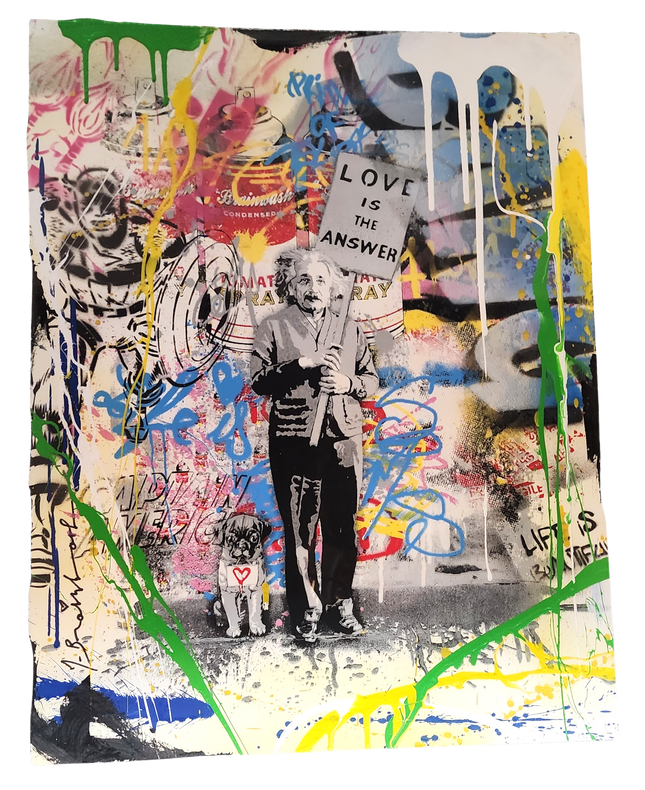
School & Education
-

Mr Brainwash- Thierry Guetta Love is the Answer Unique HPM Spray Paint Silkscreen by Mr Brainwash- Thierry Guetta
Love is the Answer Unique Original HPM Spray Paint Silkscreen Print by Mr. Brainwash- Thierry Guetta Mixed Media Screen Print on Deckled Fine Art Paper Limited Edition Pop Street Art Artwork. 2015 Signed with COA Spray Paint, Acrylic Paint Mixed Media Unique HPM Embellished Original Artwork Size 16x21. Famous Theoretical Physicist Albert Einstein Holding a Sign Reading "Love is the Answer" with Tons of Colorful Spray Paint & Paint Hand-Embellished. Love is the Answer: A Portrayal of Genius in Street Pop Art In the eclectic and vibrant contemporary art world, "Love is the Answer" emerges as a profound statement piece crafted by the renowned street artist Mr. Brainwash, known off the canvas as Thierry Guetta. This mixed media screen print on deckled fine art paper is a limited edition piece that seamlessly melds the realms of pop and street art with the iconic image of Albert Einstein. Crafted in 2015, "Love is the Answer" is a unique original hand-painted multiple (HPM) with a silkscreen print foundation, over which Mr. Brainwash has applied spray paint and acrylic paint by hand. This hand-embellishment process ensures that each piece within the series is a one-of-a-kind work of art imbued with its individuality and character. The artwork dimensions are a substantial 16x21 inches, giving the piece a presence that captivates the viewer and invites contemplation. The subject of the artwork is the famous theoretical physicist Albert Einstein, who is depicted holding a sign that reads "Love is the Answer." This message, combined with the visual cacophony of vibrant spray paint, creates a juxtaposition that is at once striking and thought-provoking. The image of Einstein, synonymous with intelligence and insight, coupled with a simplistic yet universal message about love, prompts a dialogue about the complexities of the human condition and the simplicity of its resolution through love. Signature Style of Mr. Brainwash Mr. Brainwash is pivotal in bringing the street art aesthetic into the gallery space. His work often incorporates figures of historical and cultural significance, placing them within a contemporary context that is both accessible and critically engaging. In "Love is the Answer," the artist's signature style is evident: a base of monochromatic tones accentuated with explosions of color, symbolizing the chaos and vibrancy of life. Like much of Mr. Brainwash's work, this piece is more than a simple depiction; it is an interactive experience. The splatters and drips of paint do not merely adorn the paper; they disrupt and engage with the image of Einstein, suggesting that even amidst the calculated precision of science, there is room for the spontaneity and passion of art. Love is the Answer Unique HPM Cultural Impact and Collectibility As a collectible artwork, "Love is the Answer" holds a special allure. Mr. Brainwash signs it, and it comes with a Certificate of Authenticity, which adds to its desirability as a piece of art history. The mixed media elements and the limited edition nature of the work make it a sought-after item for collectors and enthusiasts of street pop art and graffiti artwork. The cultural impact of the piece is significant as well. It represents a bridge between various forms of expression, from the cerebral world of theoretical physics to the dynamic realm of street art. By placing Einstein in such a colorful and unexpected context, Mr. Brainwash invites viewers to reconsider the figure as a scientist and a messenger of peace and love. Mr. Brainwash's "Love is the Answer" is a powerful example of how street pop art and graffiti can transcend the streets and enter the pantheon of high art. The piece does more than depict a famous figure; it imbues the image with new meaning and relevance. It is a declaration that amidst the complexities and challenges of life, the simplest of truths can resonate the loudest. For collectors and admirers, owning "Love is the Answer" is not just an investment in a piece of art but an endorsement of its message and the conversation it continues to inspire.
$13,127.00


